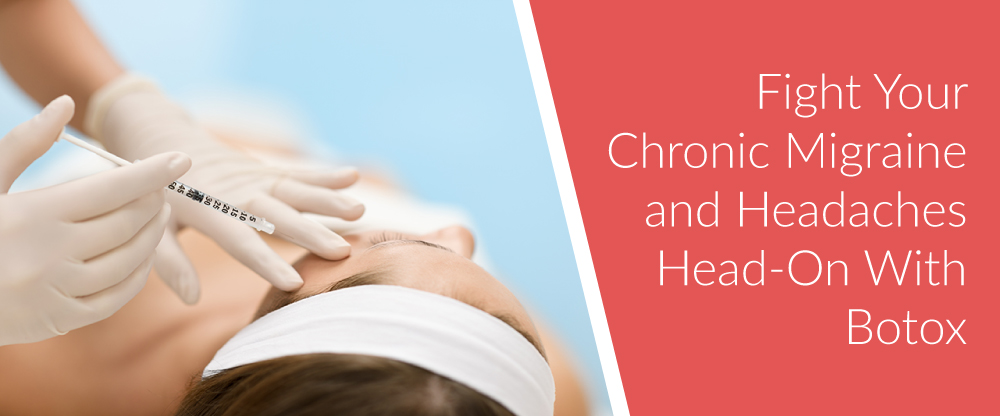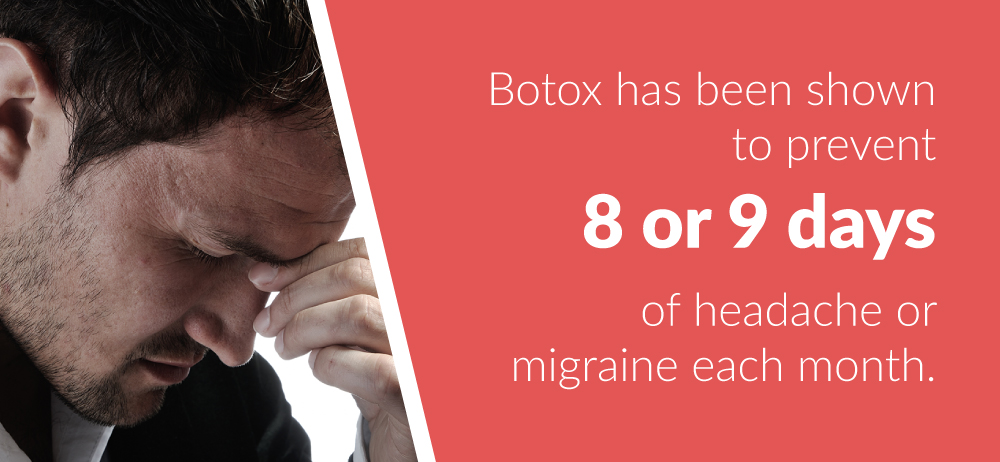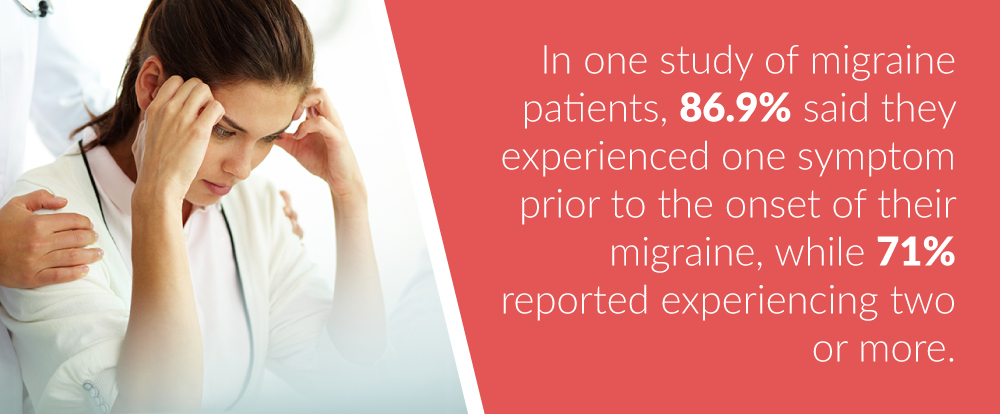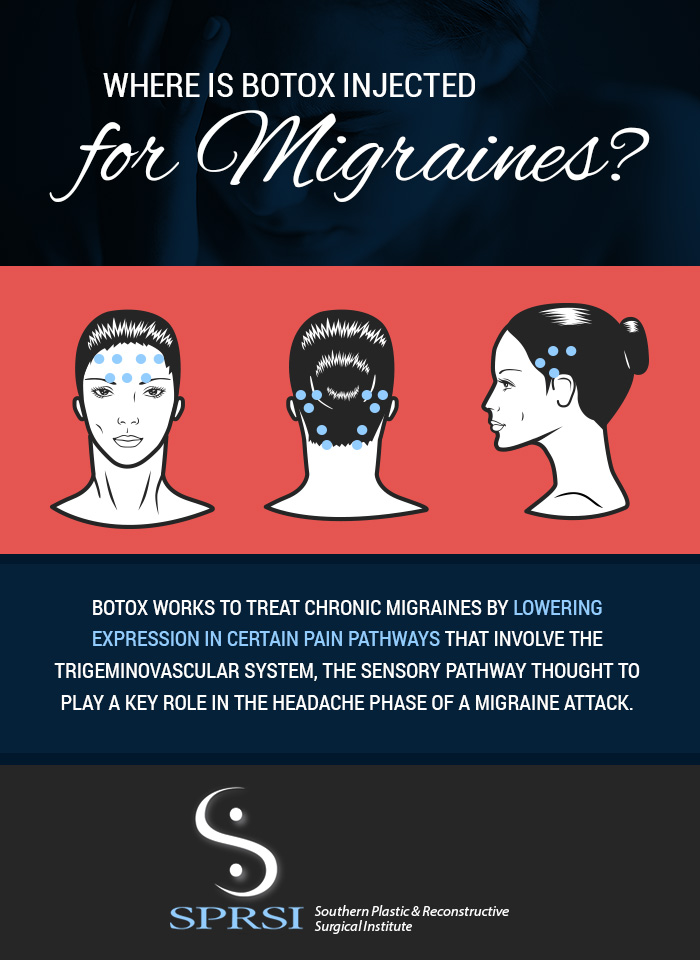Fight Your Chronic Migraine and Headaches Head-On With Botox

Virtually everyone knows someone who suffers from migraines or even suffers from migraines themselves. According to the Migraine Research Foundation, 18% of women, 6% of men and 10% of children in the US suffer from migraine headaches. Globally, the condition is the 6th most disabling ailment among working people, and in the US, costs associated with loss of productivity due to migraines are estimated to be as high as $36 billion each year.
Unfortunately, most people fail to realize just how incapacitating and burdensome chronic migraines can be. One study of 520 people with chronic migraines found that more than 50% of those individuals missed five days of household work at a minimum. Only 24.3% of their counterparts with episodic migraines missed that many days of household work.
That same study found that nearly 88% of people who suffered from chronic migraines sought professional care at some point to discuss their condition. Almost 32% of study participants with chronic migraines and 25% with episodic migraine utilized migraine-targeted acute treatments. Sadly, just one-third of patients with chronic migraines were currently utilizing preventive medications for their headaches at the time of the study.
You know your migraine isn’t just a headache, and your treatments shouldn’t be limited to just resting in a dark room and waiting for it pass. If other preventive treatments and over-the-counter remedies have not helped to quell your migraines, it’s probably a good time to start investigating your Botox treatment options. Do not simply just take more medication thinking that will help you. The most common reason why episodic migraines become chronic is medication overuse.
In 2010 the FDA expanded the indication for Botox (onabotulinumtoxinA), traditionally used to smooth out face wrinkles, to include it as a preventive treatment for chronic migraine headaches in adults. It can serve as an alternative treatment and can help you avoid medication-induced migraines and prevent against recurring chronic migraines.
Understanding the Symptoms of Migraine
A migraine is definitely not just a really bad headache. If you’re going to get a migraine, you’ll want to be as prepared as possible. There are many tell-tale symptoms that a migraine could be coming on. In one study of migraine patients, 86.9% said they experienced one symptom prior to the onset of their migraine, while 71% reported experiencing two or more. The following are common premonitory symptoms:
- Aura: A visual aura normally comes in the form of lines, spots or flickering lights. Aura can last anywhere between five minutes and an hour. Normally, the headache sets in one hour after the aura subsides.
- Irritability, excitement or depression: Some people get very depressed ahead of a migraine, while others report feeling almost elated.
- A bad night’s sleep: The inability to fall asleep or wake up are common symptoms people who suffer from migraines experience. Evidence has pointed toward a relationship between poor sleeping patterns and the frequency and intensity of migraines.
- Watery eyes or a congested nose: These symptoms normally accompany a sinus headache, but many people mistakenly self-diagnose themselves to have a sinus headache when they actually have a migraine. One study found that 52% of people with self-diagnosed sinus headache actually had a migraine with or without aura.
- Throbbing pain on one or both sides of your head: Pulsating pain is a classic sign of migraines. In many cases, that throbbing occurs on just one side of the head. The Migraine Research Foundation reports that about 33% of people experiencing a migraine feel the pain on both sides of their head.
- Pain behind the eyes or in the neck area: Migraines are notorious for causing pain behind the eyes or even that runs into the neck.
- Yawning: Yawning may indicate a forthcoming migraine. In this case, yawning is near-constant, not just intermittent as it may be when you’re generally feeling tired.
- Nausea or vomiting: This can also be an indicator of an impending migraine.
- Triggers that worsen pain: The triggers might include smells, lights, noise or certain activities. This is why many people with migraines maroon themselves in dark, quiet rooms until the pain subsides.
- Speech difficulties: Physiologically, a migraine can affect many different brain functions. This can result in speech difficulties that can make you sound like you’re babbling.
- Weakness on one side of the body: People with migraines sometimes experience temporary weakness, pins and needles or numbness on one side of their body — including the face, arm or legs. This can be scary because the feeling is reminiscent of that of a stroke onset.
- Vertigo or double vision: If you experience this symptom, you likely have a “basilar-type migraine.” The double vision, vertigo or even loss of vision is associated with these types of headaches.
- “Headache hangover”: After a migraine subsides, you may feel similar to the way you feel after a long night of drinking — like you’ve been hit by a truck.
Neurological symptoms in particular occur prior to the onset of the migraine in about 15 to 20% of cases. The duration of a migraine can last anywhere between four hours and three days.
How Is a Headache Different From a Migraine?
Though people may colloquially interchange the words “headache” and “migraine,” they are certainly not the same condition. It can be hard to tell the difference, but it’s important to do so you can treat the condition appropriately. The FDA notes that Botox has not proven useful in treating less frequent migraines that occur fewer than 14 days each month of other forms of headache.
According to the Mayo Clinic, tension-type headaches are the most common form of headache people experience. You may have a tension-type headache if:
- You feel as though you have a tight band of pain, dull ache or pressure wrapping around your head.
- You experience mild to moderate pain on each side of your head.
- You’ve had a stressful day, strained your neck or skipped meals.
- You suffer from depression, anxiety or insomnia.
The duration of a tension-type headache can be anywhere from 30 minutes to a full week. They can either be occasional or chronic — or occurring more than 15 days each month. As for treatment options, tension-type headaches that occur intermittently can generally be treated with common over-the-counter medications. These include:
- Aspirin
- Ibuprofen, such as Advil or Motrin IB
- Acetaminophen, such as Tylenol
Many people have reported combining these medications with certain alternative therapy strategies yielded the best results. These alternative therapies can include:
- Meditation
- Biofeedback
- Massage and gentle neck stretches
- Heat therapy in the form of a warm compress or shower
- Relaxation training
- Cognitive behavioral therapy
Other types of headaches include:
- Cluster headache
- Sinus headache
- Acute headaches
- Hormone headaches
- Chronic progressive headache
How Does Botox Work for Migraine?
Botox is a neurotoxin derived from a purified piece of a protein found in Clostridium botulinum which is a bacterium. Botox, regardless of what approved indication you’re using it for, works by having the protein block the local receptor sites that cause muscle activity. When used for wrinkles, the area treated with Botox will lessen or eliminate the appearance of wrinkles formed by muscle contraction. To prevent the resurgence of previously treated wrinkles, you’ll have to receive Botox injections with regularity.
When Botox was approved treat headaches in 2010, the FDA indicated that Botox should be administered approximately every 12 weeks as 31 injections into seven different Botox injection sites for migraines around the head and neck area.
If given as indicated, Botox should allay future headache symptoms. A good candidate for Botox treatment for headache normally has the following characteristics:
- They suffer from headaches or migraines more than 15 days per month each month.
- They have tried preventive medications like topiramate, nortriptyline, beta blockers or calcium channel blockers and found them to be intolerable.
- They prefer going to an office once every three months for Botox injections over taking a medication each day.
Why Does Botox Work for Migraines?
Interestingly, the mechanism of action behind why Botox can help to test headaches does not involve muscle relaxation — making chronic migraine treatment a unique indication for the drug. Research suggests that Botox works to treat chronic migraine by lowering expression in certain pain pathways that involve the trigeminovascular system. Activity in the trigeminovascular system has been linked to the headache stage of a chronic migraine episode.
Use of Botox has also been linked to reduced pain for patients with lower back pain, cervical dystonia, neuropathic pain, spasticity, myofascial pain and bladder pain.
Side Effects of Botox Injections for Migraines
In clinical trials preceding the approval of Botox for headaches, 9% of participants reported experiencing neck pain versus 3% of patients taking placebo. Less common side effects of Botox injections for migraines can include:
- Headache
- Migraine
- Slight or partial paralysis of the face
- Drooping of the eyelids
- Bronchitis
- Musculoskeletal stiffness
- Muscle weakness
- Pain concentrated in one or more muscles, ligaments, bones or tendons
- Muscle spasms
- Pain at the injection-site
- Elevated blood pressure
The FDA has also included a boxed warning for Botox injections. In this warning, the agency notes that, in rare cases, the botulinum toxins could potentially spread to other areas of the body. This could incite symptoms similar to those of botulism, which can include difficulty breathing, severe underarm sweating or involuntary muscle spasms around the eyes. The FDA, however, says there are no known cases of the toxin spreading when Botox is administered at the proper dosage.
Benefits of Botox for Headaches and Migraines
In general, managing your chronic migraines with Botox can help you regain control and improve your quality of life. Using Botox also lowers the chances you’ll experience medication overuse headaches. Taking extra doses of acute headache medication to treat your migraine can have vicious consequences. First, though they may seem like a “quick fix,” acute treatment ordinarily doesn’t address your chronic migraine symptoms in any substantive way.
Second, medication overuse headache is characterized by a near-constant dull headache between your migraines — meaning you’re never truly feeling your best. Unfortunately, the only way to address the problem (complete stoppage of acute medication) often leads to its own set of withdrawal symptoms, so it’s best to avoid finding yourself in that situation in the first place.
There are four other major benefits of using Botox for migraines you should consider:
- Botox can prevent headaches and migraines before they even come on. Botox has been shown to prevent eight or nine days of headache or migraine each month. A typical migraine sufferer experiences 15 headache or migraine/probable migraine days each month.

- Botox is administered every 12 weeks, and the appointments only last about 15 minutes. In theory, you could have the procedure done once every three months during your lunch break. It’s important to note that you must keep up with your Botox appointments to continue experiencing the benefits.
- Botox is injected by a specialist. To become certified in Botox injections, the provider must be a doctor, nurse, physician, physician’s assistant or dentist, and they must pass a course. Headache specialists focus specifically on headache disorders, meaning that your Botox provider is specifically qualified to treat your condition. As of 2016 in there were 500 headache specialists practicing in the US and 38 million total migraine sufferers.
- Finally, the needle used for Botox injection is very small. It is injected into shallow muscles, and most people report that the procedure feels like tiny little pin pricks rather than a full injection. Nothing scary about it at all.
Cost and Coverage for Botox Injections
For those who meet the clinical criteria for Botox migraine treatment, commercial insurance plans may cover the majority or all of the cost of Botox treatments. However, you will want to check with your insurance carrier prior to booking an appointment so you have an idea of what the possible out of pocket expense might be.
If your intervention is not covered by insurance, you should expect to pay more depending on the number of units and areas requested. Nationally, the cost of Botox injections ranges between $100 and $1,000 — with the average coming to $500 per visit, but the amount of Botox for migraines may be significantly more than the dosages used for cosmetic purposes. Therefore, the cost may be proportionately increased.
Where Can I Go to Receive to Botox Injections for Migraines?
Chronic migraines are, by definition, persistent — and like patients of other chronic health conditions migraine sufferers spend exorbitant amounts of money on healthcare, limited access to the quality care they need and tend to receive too little support. Being proactive about addressing your migraine condition can prove key to ensuring a more comfortable future. Having a migraine increases the likelihood that you’ll experience a migraine in the future.
Only 4% of migraine suffers seek help from a trained headache specialist, and it would do you well to sort yourself into that sect of people. Do you live in the Franklin, Nashville, Memphis, Knoxville and Chattanooga, TN regions and think you’re a good candidate for Botox treatment for headaches or migraines? Contact or schedule an appointment with Dr. Nathan Brought at the Southern Plastic and Reconstructive Surgical Institute.
Dr. Brought is board-certified in plastic surgery, and he performs a broad range of cosmetic and reconstructive procedures to qualified patients. Dr. Brought also provides advanced skin care services, including Botox treatments.





